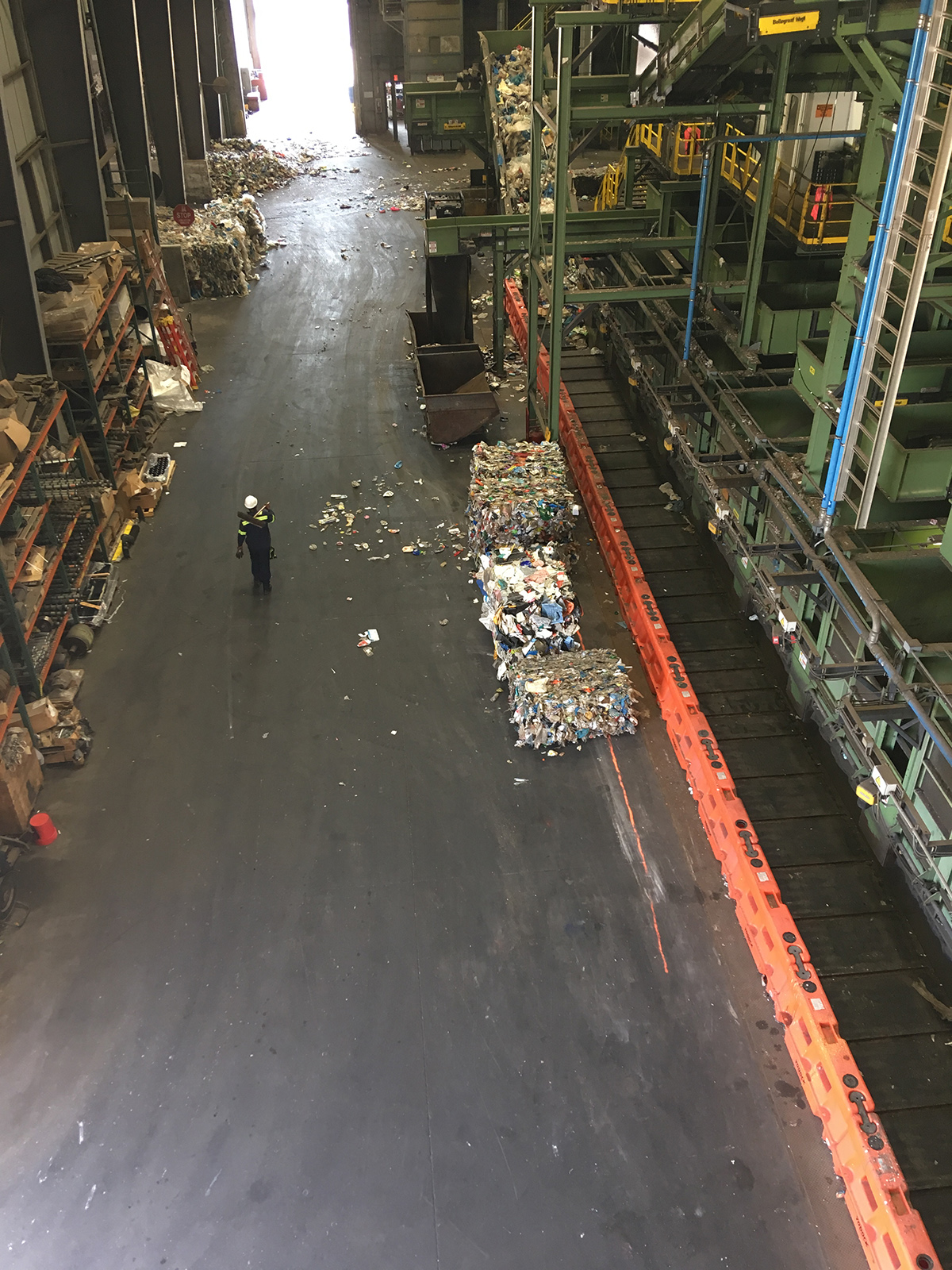small actions add up • Robert Scheuering
/SIMS Materials Recovery Facility
August 9th • Sunset Park
Those of us who live in cities don’t really know where most things we interact with come from originally or go to after we’re done with them. Food and waste especially. We’ve all been taught the holy R’s of reducing, reusing and recycling at some point in our lives, and many of us dutifully separate our trash and recycling each week knowing a big loud truck will pick it up for us. But then what?
SIMS Municipal Recycling handles most of all the recycling in NYC picked up curbside by sanitation trucks. With a city of almost 9 million people, that’s quite a lot of recyclable material (around 250,000 tons a year). Located in Sunset Park on the water and overlooking the Manhattan skyline, the Brooklyn plant is the most state of the art and largest commingled recycling facility in North America. With an elevated pier for flood protection, the only commercial scale turbine in NYC, and a full education center for youth and adults alike (with activities like spin the job wheel to contemplate a different career in the recycling field), it makes for a unique blend of industrial powerhouse and green future integration.
When Robert Scheuering applied to the 360 program as a sound artist, writing that he enjoys “really delving into, electronically altering, and sitting with sounds that seem boring to find something going on inside them that may have been overlooked,” we knew we had to find something worthy of the challenge. After being denied by the Hunts Point Meat Market (no outside visitors are allowed), we found SIMS Recycling Facility. Where else would be so excited to transform the crunch of metal and the electric whine of a giant crane into a creative process?
Kara Napolitano, the Outreach and Education Coordinator greeted us, gave us a mini-tour and explained some of the fundamentals of the sorting process. Visit for yourself - they have free monthly tours. Check them out here.
Here are Rob’s reflections and the piece he worked on during the residency:
My time at SIMS Municipal Recycling was spent recording, listening, and editing together sound. As someone who's never done a residency, it was a great feeling to know I had 6 hours dedicated just to making something. It was surreal to have time to dedicate after a regular work week.
It was a great experience to see the work that goes into recycling and the processes involved in sorting materials to prepare them for shipping. At first listen, the sounds of the facility were homogeneous. If you listened closely though, you could hear clinks and clanks of bottles, rustles of paper, and plastic sounds..
The connection I made from this experience is: combating the world's climate crisis needs to happen on an individual level as well as a systematic one. Individually, it is overwhelming, but small actions gradually add up. I felt like being in this space allowed me to reflect on the importance of individual action to combat climate change as well as the necessity of shifting systems that have allowed climate change to go unchecked. That said, I'm very grateful to have been given the opportunity to work in such an inspiring space.
Listen to the sound composition Robert made during his micro-residency.
He recommends listening through speakers or headphones:
Afterthoughts…
SIMS is not a Recycling plant per se- it’s a recovery plant that sorts materials and sends them places where they can be recycled. Actually recycling materials is not as easy as putting it in the bin and patting your back for a job well done. Fears of it all being a waste of resources and time, that recycling has ceased as we know it now that China isn’t buying our barges full of plastic are not completely unfounded.* But neither is swearing the whole thing off and cynically throwing your cans in the trash with a shrug of “doesn’t matter anyways,” The habit of recycling is actually the hardest to create, and now that we are used to separating our plastics, cardboard and glass, perfecting and improving the system to be more efficient and to have materials be designed with their return to the market in mind instead of as one-use throw-aways is the imperative. Do any reading from Cradle to Cradle material efficiency gurus like William McDonough & Michael Braungart and you realize how intensive the process of recycling actually is, sometimes creating more environmental harm than help. But also see how by widening the scope to think about recycling when something is designed, before it is made and is no longer needed by a consumer, can be the key to regenerative materials and economy. That’s one of our biggest reasons that Holes in the Wall Collective wants to make a Center for Research, Reflection and Action. To give time and space to people before the crisis to make the conditions not arise in the first place. And as Rob said, every little thing does add up. So keep recycling, sign up for our teaspoon brigade and when you can, opt to use something again or not at all instead of recycling it (buy bulk, use a water bottle, eat-in instead of take-out, buy something in your hood instead of from amazon, etc.) The more we are aware of where things come from and where they are going, the more we can do to make choices that matter.
*For the record, SIMS hasn’t been sending recyclable bales to China for quite some time, so they haven’t been in the pickle many other municipalities have found themselves in with the abrupt stop of receiving the glut of American plastics.







